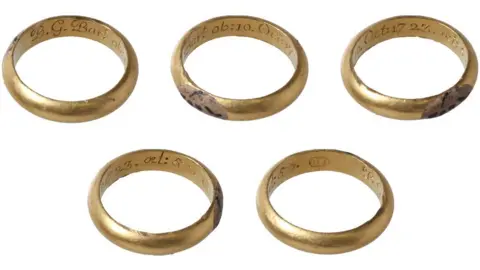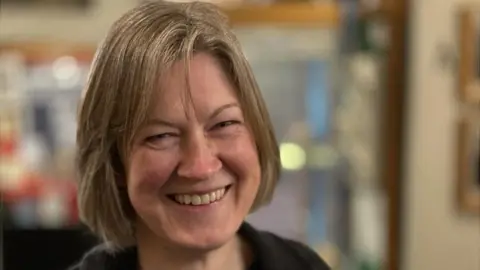Museum hopes to acquire 'rackety' baronet's ring
 Andrew Williams/Norfolk County Council
Andrew Williams/Norfolk County CouncilA gold mourning ring that was made in memory of a dead baronet has been found in a field.
The 20mm (0.7in)-round jewel was discovered by a metal detectorist near Thetford, Norfolk, in August.
Historian Helen Geake was able to connect it to landowner Sir Bassingbourne Gawdy thanks to its inscription. He was a "notable sportsman" who researchers said liked "rackety exploits".
The ring is the subject of a treasure inquest and Norwich Castle Museum hopes to acquire it.
A coroner at a treasure inquest typically decides whether the discovery is treasure, and therefore whether a museum should have first refusal over it.
Sir Bassingbourne died in a hunting accident in 1723.
A baronet was a title in the British aristocracy that was passed down through families.
 Andrew Williams/Norfolk County Council
Andrew Williams/Norfolk County CouncilDr Geake, who is the finds liaison officer for Norfolk, said mourning rings were made to remember a person who had died.
People would leave money in their wills for rings to be created and distributed to family and friends in their memory.
Naval administrator and diarist Samuel Pepys wrote about being given one in the 1660s.
This find was inscribed in Latin B.G. Bart. ob: 10. Oct: 1723. aet: 56, which translates as B.G. Baronet, died 10th October 1723, aged 56.
Dr Geake's investigations revealed Sir Bassingbourne lived at West Harling, east of Thetford.
He never married and was described as a "notable sportsman" who enjoyed "rackety exploits" by the Oxford Dictionary of National Biography.

"What is also interesting is he was the grandson of the celebrated painter Sir John Gawdy, who was born deaf," Dr Geake said.
He and his brother Framlingham, who was also deaf, were the first known deaf people in Britain to be educated through the use of sign language, according to the British Deaf History Society.
Dr Geake said the ring would not have been classed as treasure if it had been found a year earlier.
This is because the Treasure Act 1996 categorises a find as treasure if it is at least 300 years old and made at least in part of precious metal, like gold or silver.
So if the ring had been found in August 2023 - not August 2024 - the detectorist and landowner would not have had to declare it.
Follow Norfolk news on BBC Sounds, Facebook, Instagram and X.
